The 1920s was an era where women were prized by the stockings, shoes, and items of clothing that they wore. Attention was given to women who were well-dressed and exuded a sense of professionalism. Women were typically identified based on their choice of clothing: it was a sense of pride and identity.
Women’s legs, however, had never received as much attention as they did in the roaring twenties. With the introduction of flapper dresses that accentuated the knee area all the way down to their feet, it was daring and popular. Before the roaring twenties, the sole purpose of socks was for warmth and protection. However, with the introduction of more provocative and sophisticated flapper-style dresses, more attention was given to women’s leg area. Yet again, stockings became integrated into their daily looks – it was seen as an accessory.
Extensive collections of stockings came to life. At the time, women had to wear some kind of stockings to cover their legs. As more dresses came right above their knees, they had to incorporate stockings into their choices of outfits for coverage and warmth. The material of stockings in the roaring twenties was usually made out of silk or rayon stockings. Stockings today, however, differ greatly as it is usually made in silk, cotton or synthetic rayon, new material in this era. At the time, cotton stockings were available but they were not quite as popular – it was not seen as fashionable in the roaring twenties. The best mixture of materials in the contemporary past was made out of a hybrid of silk and rayon which provided the most long-lasting touch in terms of the incorporation of materials and styles.
Rolled Stockings
Stockings came about mid or upper thigh area and had to be held up and clipped. It was typically attached to either a corset or a girdle with clips or gilt mounts. For some women, they preferred to use elastic bands or to simply roll their stockings down using elastic bands to just above the knee area. The choice was simply theirs!
With whatever material they could use, they made the best use of it, hence, placing creativity over anything else!
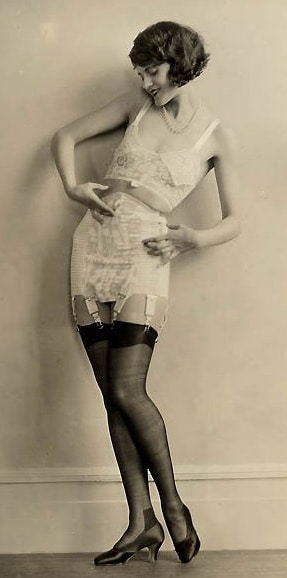
While methods were more preferred than the others, there was a fundamental reason for it. For women who did not clip their stockings to either their corsets or with gilt mounts or clips, they were fixing their rolls several times a day. This causes great disruption to their everyday process and acts as a distraction to their ongoings. However, with more practice came successes. Once they were able to master the act of rolling their stockings in a feasible manner, they did it without fail.
Rolled Stockings: Flapper Edition
With whatever material they could use, they made the best use of it, hence, placing creativity over anything else!
Flappers were known to roll their stockings all the way down to their knees. This was used to make sure that their knees were bare. Even so, they applied a bit of makeup to their knees to enhance the look and beauty of their knees. As it was forbidden during the contemporary days to be seen with their knees uncovered, women took each and every opportunity available to show their bare knees. It was both provocative and daring to be able to show one’s knees! What an opportunity during the golden days. Now, it all seems silly that these rules and regulations were put in place during those days.
Glamour and glitz were all they wanted. When they had the opportunity to involve themselves in a little daring and provocative act, so will they!
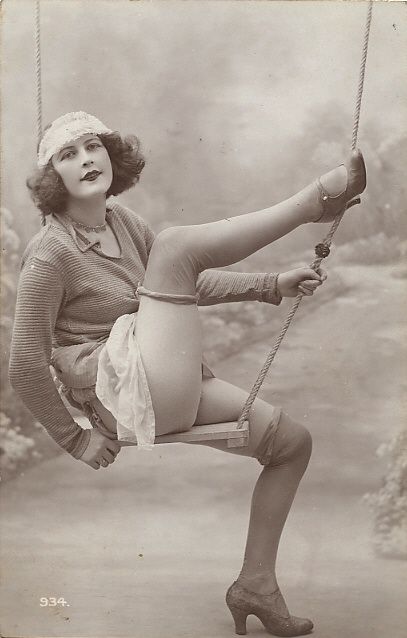
For flappers that were fancier than the others, their stockings were typically decorated with gold or silver bands are worn just above the left knee. Their stockings were attached to garters. The bands can be seen and visible when the flapper dances expose their upper knee areas. Yet again, this came as a shock for the older generations that were not too fond of the flapper girls exposing their upper knee area. The older generations were probably surprised by the fact that women during the roaring twenties transformed the looks of the older generations and posed a great twist to their choices of clothing. What an interesting revelation!
Rolled Stockings: At the Beach!
Another time rolled stockings were popular was at the beach!
Interestingly, stockings were worn at the beach! With flippers and flip-flops of this era in contemporary today, women wore stockings to the beach. However, the stockings that they were did not fit the obligated measurements for beaches. They were told to cover their knees if it went above their knees, some beaches prohibited women from entering or using beach facilities.
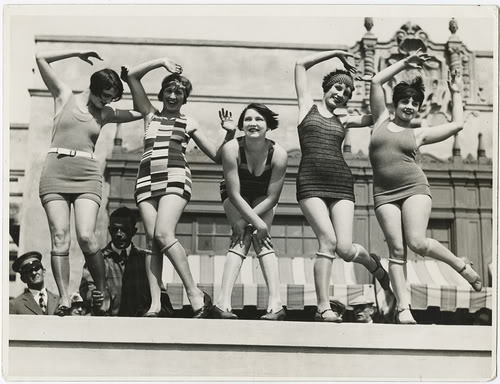
The gap between the knee and the swimsuit skirt was known as jarring and provocative during those times, hence, they were not allowed to enter some beaches where rules were imposed more strictly than others.
Style of Stockings:
There are four main styles of stockings: full-fashioned, semi-fashion, tubular, and cut.
- Full-fashioned stockings – These stockings are typically the best types of stocking constructions. It has the least amount of bagging at the ankles. This was the preferred length of stockings that was widely accepted during the roaring twenties.
- Semi-fashioned stockings – These are of circular knit.
- Tubular hose – These are usually made for children; they are not shaped.
- Cut hose – these are tubes stitched on a circular knitting machine, then cut the length of a leg. Only the poor were able to afford this and it was only worn exclusively by them.

Stockings came in various shapes and sizes. It was a number that reflected the shoe sizes. There was a typical little stretch to them, hence, it was technically only best fit for certain classes of people that fit the ideal body type in the roaring twenties. These stockings conventionally bag at the ankles, hence, it was loosely-fitting in that area.
Also, for the stockings that were shearer than the rest, you could see leg hair underneath. Shaving underarms have been incorporated into their daily lives for decades now, but the removal of leg hair is still a new concept during the roaring twenties. Most advertisers praised the need for glossy and smooth legs – they mentioned that the smoother the legs were, the better looking the stockings will be. This mentality struck many girls as they decided to shave their legs for a better touch on the stockings. This mentality was mostly adopted by the flapper girls as they were the ones who needed to accentuate their leg area the most. Most women did not have the luxury or the need to shave their legs, hence, they chose not to involve themselves in the act.
Stocking yarn:
The quality was reflected in the prices of the stockings. Women were told that the more expensive the stockings were, the better quality and more durable the stockings were. It would also technically fit better, due to the enhancement in the quality of the more expensive pairings. The usual materials that were worn were usually of these kinds stated below:
- Wool stockings were slightly thicker and were usually worn in colder climates. During winter days, it was best to incorporate wool fashion into their daily choices of clothing.
- Cotton stockings were usually worn for both their durable nature and thickness. Quality depended on the price factor. Cotton was easy to repair in heels and toes, where most of the damage occurs in that area.
- Lisle was mostly worn by the poor. It was usually the more affordable option out of the collection. It was worn for everyday ideal conditions such as walking, sports, and working conditions.
- Rayon was artificial silk. It was usually mixed with other breeds of fiber that will present the best of both worlds.
- Silk was the easier to wash, less baggy option.
What colors were there?
During the earlier years, women’s stockings were plain black. There were more incorporations of different colors throughout the years. Black was most common with the addition of grey, brown, or even white.

These options were coordinated with winter dresses and their outfits of the day. Comfort and fashion were two main elements that they looked for in the choices of its stockings.
In winter, the materials worn were usually made out of wool, cotton, or cashmere. Silk was an option for more breathable climates such as during summer or warmer climates were they praised comfort and breathable luxuries.
By the mid-twenties, there were other colors such as nude. Nude was a newly incorporated fashion that was supposed to mimic women’s skin color during those times. They came in a few varieties of shade that were only exclusive to certain types of body colors. Now, there is an extensive collection when it comes to nude itself.
The consensus was lighter stockings during summer and darker ones in winter. These were not hard rules and each woman dressed according to their wants and needs. The end discretion was up to them.
By the end of the roaring twenties, the stocking colors expanded to different colors. They expanded into new pastel shades such as purple, cream, light green, yellow, pink, and other colors. In the evenings, women would match their stockings to dresses. Due to the increase in choices, women were allowed to involve themselves in more shades and tones – a happier society!
Stockings were also coordinated with accessories such as handbags, gloves, or dresses. You can witness how rich a woman’s sense of fashion is when you witness how she coordinates her socks from her outfits. Usually, the ones who dress will tend to stand out from the crowd as opposed to the ones who pair it poorly.
Sport stockings
While most stockings were of simple, plain, and solid colors, there was also a good hybrid of patterned stockings.
These sport socks were also associated with its funky prints. These were similar patterns found in sweaters during the contemporary past.
Socks had yet to catch on for daywear in the 1920s. Children wore them, men wore them, but women wore stockings.
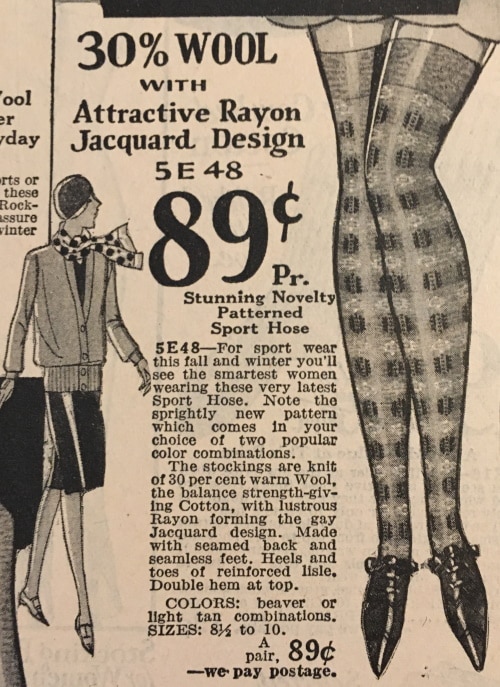
Ankle socks were not that popular during the era, especially for women. They were supposed to replace stockings but to be worn over them as an added layer of warmth and fun fashion. The mix and match were crazy during this era.
They were so popular that it became a popular trend in the 1930s! Many people loved this new fashion and it thrived in this era.
Decorations
While most of the stockings were of plain, solid colors, they did not lack decorative features. There were lace, embroideries, and simple patterns that were implicit but present.
Embroidery was also placed in the form of flowers, animals, and other popular patterns of the era. There were religious art and motifs behind the embroidery patterns. Some sequins or other elements were added to increase the dimension and style!
Stripe stockings were also popular during the roaring twenties.
What about fishnets?
Fishnets were simply too provocative and revealing for the roaring twenties. Well, they were worn only by a minority of girls, but it was seen as too provocative and jarring considering the restrictive fashion and choices of clothing in this era. They slowly became associated with flapper girls in the 1950s revival of the 1920s where showgirls usually wore fishnets. They added an eccentric fashion and touch to the performances in musicals and shows during the roaring twenties!
Wrap-up:
To summarize, the 1920s was an era where women were prized by the stockings, shoes, and clothing that they wore. Attention was given to women who were well-dressed and exuded a sense of professionalism. Women were typically identified based on their choice of clothing: it was a sense of pride and identity.
In this article, we have discussed the various types of stockings that were available: purpose, how it was worn, why it was worn, by whom was it worn by and we have added our personal inferences on what we thought about each of the stockings. Yet again, stockings became integrated into their daily looks – it was seen as an accessory. Glamour and glitz were all they wanted. When they had the opportunity to involve themselves in a little daring and provocative act, so will they!
With whatever material they could use, they made the best use of it, hence, placing creativity over anything else!
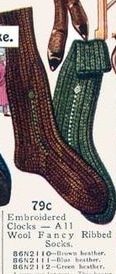
Even interestingly, stockings were worn at the beach! With flippers and flip-flops of this era in contemporary today, women wore stockings to the beach. This presented a new avenue for women’s fashion!
We have discussed:
- Rolled stockings: Stockings came about mid or upper thigh area and had to be held up and clipped. It was typically attached to either a corset or a girdle with clips or gilt mounts. For some women, they preferred to use elastic bands or to simply roll their stockings down using elastic bands to just above the knee area. The choice was simply theirs!
- Styles of stockings
- Full-fashioned stockings – These stockings are typically the best types of stocking constructions. It has the least amount of bagging at the ankles. This was the preferred length of stockings that was widely accepted during the roaring twenties.
- Semi-fashioned stockings – These are of circular knit.
- Tubular hose – These are usually made for children; they are not shaped.
- Cut hose – these are tubes stitched on a circular knitting machine, then cut the length of a leg. Only the poor were able to afford this and it was only worn exclusively by them.
- Fishnets– They slowly became associated with flapper girls in the 1950s revival of the 1920s where showgirls usually wore fishnets.
- Decorative stockings – Embroidery was also placed in the form of flowers, animals, and other popular patterns of the era. There were religious art and motifs behind the embroidery patterns. Some sequins or other elements were added to increase the dimension and style!
- Sport stockings– While most stockings were of simple, plain, and solid colors, there was also a good hybrid of patterned stockings.

